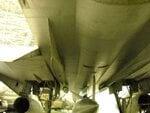The first design I can readily think of is the XGAM-67 Crossbow (USAF)
- Requirement issued in 1953: It was designed to help XB-50's penetrate the USSR
- The design was based on the RP-54 Drone, which was, in turn, based on the Q-3
- It seemed to be designed for anti-radar first, but was ultimately cancelled due to technological problems and subsonic only speed (1957).
- There were proposals to use it as a chaff-layer which could fly a race-track pattern as the bombers would go through, an automated ECM platform, as well as a reconnaissance device.
- Dimensions & Weights
- Length: 20'0.2"
- Diameter: 32"
- Wingspan: 12'7.8"
- Weight: 2700 pounds
- Range: 300 miles
- It was expected to have a range of 200 miles
- Was jet-powered and could cruise at subsonic speed, with a supersonic dash
- Cancelled in 1960 (unsure what part of 1960).
- Requirement issued in April 1955
- It was capable of supersonic speed, able to home on radar, or be illuminated by radar from an attacking aircraft.
- It could carry a nuclear or conventional warhead.
- Glided flights began in March of 1960
- Program was cancelled in July of 1960 when the USAF asserted control over long-ranged missile programs, and them dumped it
- Dimensions & Weights
- Length: 16'0"
- Diameter: 19"
- Wingspan: 5'0"
- Weight: 1750 pounds
- Performance & Range
- Speed: Mach 3.75
- Altitude: 50000'
- Range: 170 nm at high altitudes; 100 nm at low altitudes

